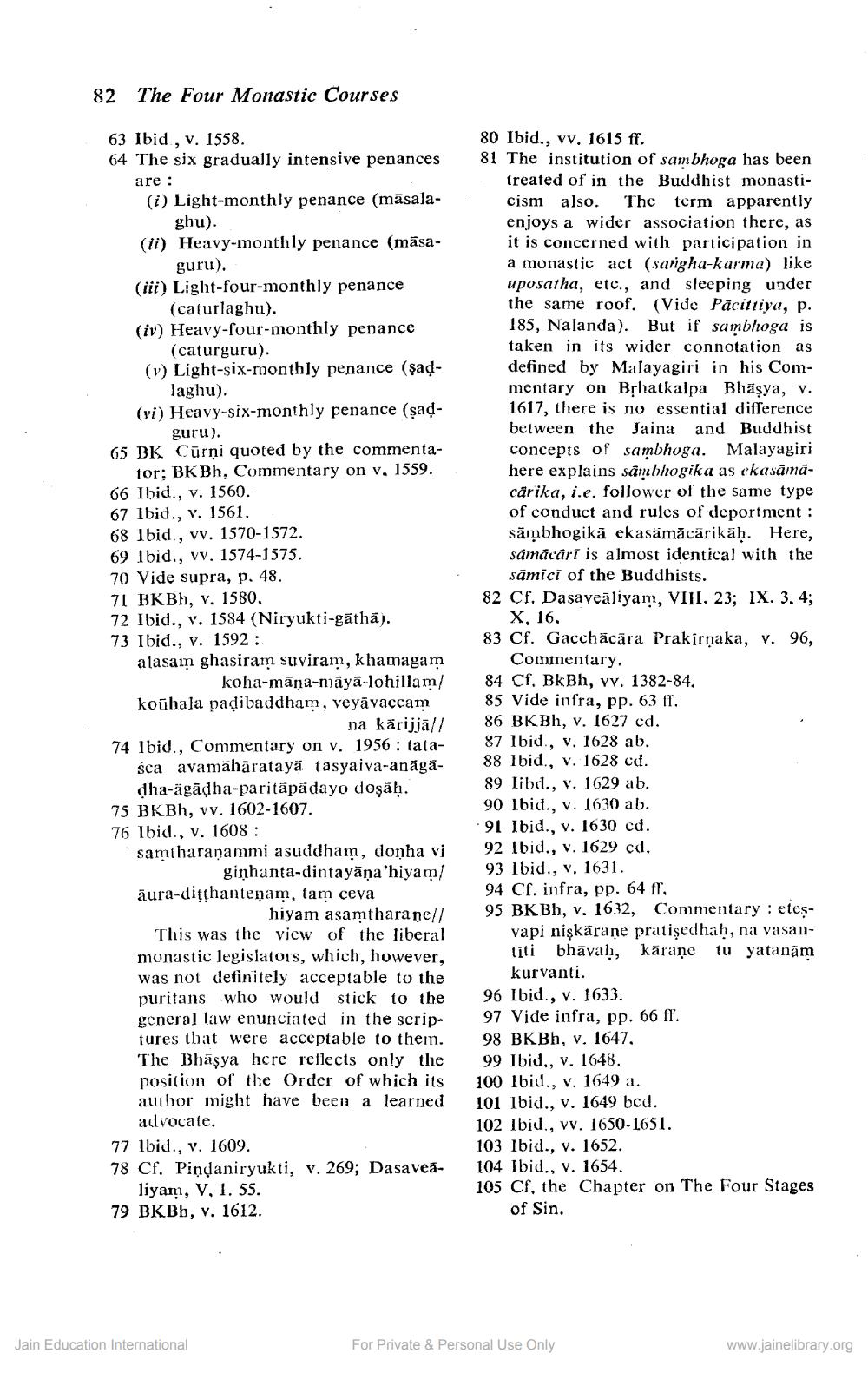________________
82 The Four Monastic Courses
63 Ibid, v. 1558.
64 The six gradually intensive penances
are:
(i) Light-monthly penance (māsalaghu). (ii) Heavy-monthly penance (māsa
guru).
(iii) Light-four-monthly penance (caturlaghu).
(iv) Heavy-four-monthly penance (caturguru).
(v) Light-six-monthly penance (şadlaghu).
(vi) Heavy-six-monthly penance (sad
guru).
65 BK Cūrṇi quoted by the commentator: BK Bh, Commentary on v. 1559. 66 Ibid., v. 1560.
67 Ibid., v. 1561.
68 lbid., vv. 1570-1572.
69 lbid., vv. 1574-1575.
70 Vide supra, p. 48.
71 BKBh, v. 1580.
72 Ibid., v. 1584 (Niryukti-gäthä).
73 Ibid., v. 1592.
alasam ghasiram suviram, khamagam koha-māṇa-maya-lohillam/
koūhala paḍibaddham, veyāvaccam na kārijjā//
74 lbid., Commentary on v. 1956: tataśca avamahārataya tasyaiva-anāgādha-ägadha-paritäpädayo doṣaḥ.
75 BKBh, vv. 1602-1607.
76 Ibid., v. 1608:
samtharanammi asuddham, donha vi ginhanta-dintayāṇa'hiyam/
aura-ditthanteņam, tam ceva
hiyam asamtharaṇe//
This was the view of the liberal monastic legislators, which, however, was not definitely acceptable to the puritans who would stick to the general law enunciated in the scriptures that were acceptable to them. The Bhasya here reflects only the position of the Order of which its author might have been a learned advocate.
77 lbid., v. 1609.
78 Cf. Pindaniryukti, v. 269; Dasavealiyam, V, 1. 55.
79 BKBh, v. 1612.
Jain Education International
80 Ibid., vv. 1615 ff.
81 The institution of sambhoga has been treated of in the Buddhist monasticism also. The term apparently enjoys a wider association there, as it is concerned with participation in a monastic act (sangha-karma) like uposatha, etc., and sleeping under the same roof. (Vide Pacittiya, p. 185, Nalanda). But if sambhoga is taken in its wider connotation as defined by Malayagiri in his Commentary on Bṛhatkalpa Bhāṣya, v. 1617, there is no essential difference between the Jaina and Buddhist concepts of sambhoga. Malayagiri here explains sambhogika as ekasāmācărika, i.e. follower of the same type of conduct and rules of deportment: sambhogikā ekasämācārikāḥ. Here, sāmācārī is almost identical with the sămici of the Buddhists.
82 Cf. Dasaveāliyam, VIII. 23; IX. 3. 4; X, 16.
83 Cf. Gacchäcära Prakirṇaka, v. 96, Commentary.
84 Cf. BkBh, vv. 1382-84. 85 Vide infra, pp. 63 fr.
86 BKBh, v. 1627 cd. 87 Ibid., v. 1628 ab. 88 Ibid., v. 1628 cd. 89 libd., v. 1629 ab. 90 Ibid., v. 1630 ab. 91 Ibid., v. 1630 cd. 92 Ibid., v. 1629 cd.
93 lbid., v. 1631.
94 Cf. infra, pp. 64 ff,
95 BKBh, v. 1632, Commentary: etesvapi nişkärane pratisedhah, na vasantu yatanām
titi bhavaḥ, kāraṇe kurvanti.
96 Ibid., v. 1633.
97 Vide infra, pp. 66 ff. 98 BKBh, v. 1647. 99 Ibid., v. 1648. 100 Ibid., v. 1649 a. 101 Ibid., v. 1649 bcd.
102 Ibid., vv. 1650-1651.
103 Ibid., v. 1652.
104 Ibid., v. 1654.
105 Cf, the Chapter on The Four Stages of Sin.
For Private & Personal Use Only
www.jainelibrary.org




